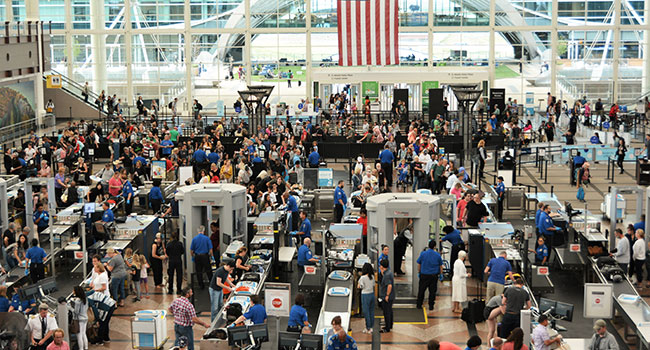
TSA Prepared for a Busy Holiday Travel Season
SA highlights state-of-the-art X-ray scanner in use at MFR security checkpoint
The Transportation Security Administration (TSA) is anticipating that security checkpoints locally and nationwide will be busy during the upcoming holiday travel season. TSA at Rogue Valley International - Medford Airport (MFR) is prepared for the expected surge in holiday travelers who will depart the airport in the coming weeks.
The busiest times at the TSA security checkpoint at MFR are 3:30 a.m. to 6 a.m.; 10:30 a.m. to 1 p.m. and 3 p.m. to 5 p.m. The busiest days to travel are Thursdays and Fridays as well as Sundays and Mondays. The flight departure schedules are set up by the airlines, and are considered peak flying times. The security checkpoint at MFR opens daily at 3:30 a.m.
Currently, departing passenger volumes at MFR are 97% of 2019 levels. TSA anticipates that departing passenger volumes locally will exceed 2019 levels on some days leading up to Thanksgiving and immediately after the holiday. The same will be true for the end-of-the-year holiday travel season.
Travelers departing MFR will see a computed tomography (CT) scanner in use to screen carry-on luggage in the checkpoint. The CT unit applies a sophisticated algorithm as it generates a 3-D image of the contents of a traveler’s bag. A TSA officer can manipulate the 3-D X-ray image to allow for a better view of the bag’s contents, resolving potential security threats on-screen and ultimately reducing the number of bag checks that are required. In addition, travelers can leave everything in their carry-on bag, including electronics, travel-size liquids and food as it is screened through a CT scanner.
While TSA concentrates on security, here are five things travelers can do now to be prepared for the screening experience during the holidays.
COVID-19 protocols are still in place, so do not forget to wear a mask. The federal requirement to wear a mask anywhere in the nation’s transportation system remains in effect through January 2022. Travelers are required to wear a mask anywhere in the airport and while onboard an aircraft. Travelers will be asked to adjust their masks to verify their identity when providing their photo ID and boarding pass at the entrance to the checkpoint. TSA recommends packing a few extra masks in the event in case a mask gets dirty during the trip.
Enroll in TSA PreCheck® now to expedite security screening and reduce touchpoints. Travelers who are enrolled in TSA PreCheck do not have to remove their shoes, belts, lightweight jackets, electronics larger than a cell phone or their bag of travel-size liquids and gels during screening. Not only is that convenient, but it also reduces touchpoints when transiting the security checkpoint.
If you enroll by mid-November, you will likely be eligible for TSA PreCheck by Thanksgiving. Learn where the closest enrollment center is and start the enrollment process at www.tsa.gov/precheck.
Use gift bags instead of wrapping paper. Wrapped items will be screened just like any other item. If a wrapped item alarms the security screening technology whether in carry-on or checked luggage, a TSA officer may have to unwrap it to determine what the item is and confirm it does not pose a security threat. Consider traveling with unwrapped items or placing them in a gift bag for easy access and resolution.
Make a plan for traveling with special holiday foods and drinks. We know that many passengers like to travel with special foods and drinks to share with friends and families during the holidays. Remember that not all foods are suitable for carry-on luggage. If you can spill it, spread it, spray it, pump it or pour it AND the quantity exceeds 3.4 ounces (which is 100 ml), pack it in a checked bag. For example, cranberry sauce, jams and jellies as well as gravy and wine in quantities larger than 3.4 ounces should go in a checked bag. Cakes, pies and casseroles can travel in carry-on luggage, but may require some additional screening.
Download the free myTSA app and follow TSA on social media. The free, downloadable myTSA app is a trusted source for last-minute travel questions. It provides travelers with 24-hour access to the most frequently requested airport security information. It also features a searchable “Can I Bring” database where you can type in the name of an item and the app will let you know if you should pack it in your checked or carry-on bag. The app is available from the App Store or Google Play.